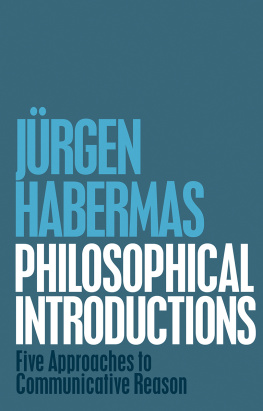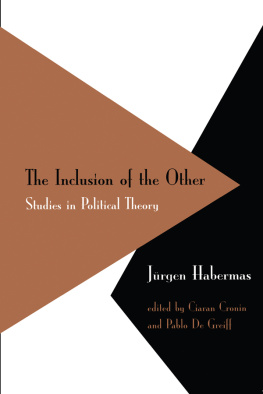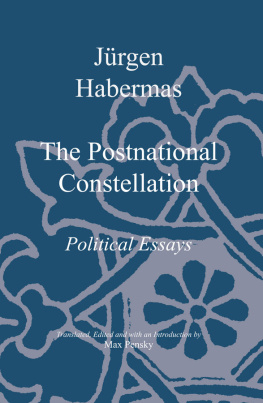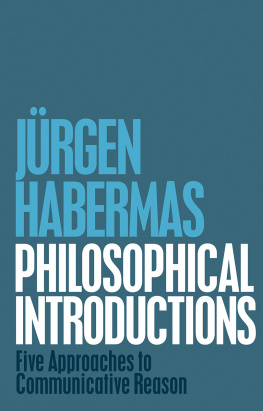Thinking Gender
Edited by Linda Nicholson
Also published in the series
Feminism/Postmodernism
Linda Nicholson
Gender Trouble
Judith Butler
Words of Power
Andrea Nye
Femininity and Domination
Sandra Bartky
Disciplining Foucault
Jana Sawicki
Beyond Accommodation
Drucilla Cornell
Embattled Eros
Steven Seidman
Erotic Welfare
Linda Singer
Materialist Feminism and the Politics of Discourse
Rosemary Hennessy
An Ethic of Care
Mary Jeanne Larrabee
Feminist Epistemologies
Linda Alcoff and Elizabeth Potter
Gender Politics and Post-Communism
Nanette Funk and Magda Mueller
Engenderings
Naomi Scheman
Feminist Theory and the Classics
Nancy Rabinowitz and Amy Richlin
Postmodern Revisionings of the Political
Anna Yeatman
Moral Dilemmas of Feminism
Laurie Shrage
Subjection and Subjectivity
Diana Tietjens Meyers
Feminist Contentions
Seyla Benhabib, Judith Butler, Drucilla Cornell, and Nancy Fraser
Concluding Remarks
In general, then, the principal blindspots of Habermass theory with respect to gender are traceable to his categorical opposition between system and lifeworld institutions and to the two more elementary oppositions from which it is compounded, the reproduction one and the action-contexts one. Rather, the blindspots are traceable to the way in which these oppositions, ideologically and androcentrically interpreted, tend to override and eclipse other, potentially more critical elements of Habermass frameworkelements like the distinction between normatively-secured and communicatively-achieved action contexts and like the four-term model of public-private relations.
Habermass blindspots are instructive, I think. They permit us to conclude something about what the categorical framework of a socialistfeminist critical theory of welfare state capitalism should look like. One crucial requirement is that this framework not be such as to put the maleheaded, nuclear family and the state-regulated official economy on two opposite sides of the major categorical divide. We require, rather, a framework sensitive to the similarities between them, one which puts them on the same side of the line as institutions which, albeit in different ways, enforce womens subordination, since both family and official economy appropriate our labor, short-circuit our participation in the interpretation of our needs, and shield normatively secured need interpretations from political contestation. A second crucial requirement is that this framework contain no a priori assumptions about the unidirectionality of social motion and causal influence, that it be sensitive to the ways in which allegedly disappearing institutions and norms persist in structuring social reality. A third crucial requirement, and the last I shall mention here, is that this framework not be such as to posit the evil of welfare state capitalism exclusively or primarily as the evil of reification. What we need instead is a framework capable of foregrounding the evil of dominance and subordination.48
NOTES
1. I am grateful to John Brenkman, Thomas McCarthy, Carole Pateman and Martin Schwab for helpful comments and criticism; to Dee Marquez and Marina Rosiene for cracker jack word processing; and to the Stanford Humanities Center for financial support.
2. Karl Marx, Letter to A. Ruge, September 1843, in Karl Marx: Early Writings, Rodney Livingstone and Gregor Benton, trans., (New York: Vintage Books, 1975), p. 209.
3. Jrgen Habermas, The Theory of Communicative Action, Vol. I: Reason and the Rationalization of Society, Thomas McCarthy, trans., (Boston: Beacon Press, 1984). Jrgen Habermas, Theorie des kommunikativen Handelns, Vol. II: Zur Kritik der funktionalistischen Vernunft, (Frankfurt am Main: Surhkamp Verlag, 1981).
I have consulted the following English translations of portions of Theorie des kommunikativen Handelns, Vol. II: Habermas, New Social Movements, (excerpt from Ch. VIII, Section 3) Telos, 49 (1981), pp. 33-37; Marx and the Thesis of Inner Colonization, (excerpt from Ch. VIII, Section 2, pp. 52247), Christa Hildebrand and Barbara Correll, trans., unpublished typescript; Tendencies of Juridification, (excerpt from Ch. VIII, Section 2, p. 522 ff), unpublished typescript.
Other texts by Habermas: Legitimation Crisis, Thomas McCarthy, trans., (Boston: Beacon Press, 1975). Introduction, in Observations on The Spiritual Situation of the Age: Contemporary German Perspectives, Jrgen Habermas, ed., Andrew Buchwalter, trans., (Cambridge, MA: MIT Press, 1984). A Reply to my Critics, in David Held and John B. Thompson, eds., Habermas: Critical Debates, (Cambridge, MA: MIT Press, 1982).
I have also consulted two helpful overviews of this material in English: Thomas McCarthy, Translators Introduction, in Habermas, Theory of Communicative Action, Vol. I, pp. v-xxxvii.; John B. Thompson, Rationality and Social Rationalisation: An Assessment of Habermass Theory of Communicative Action, Sociology, 17, 2 (1983), pp. 278-94.
4. I shall not take up such widely debated issues as Habermass theories of universal pragmatics and social evolution. For helpful discussions of these issues, see the essays in Held and Thompson, eds., Habermas: Critical Debates.
5. Habermas, Theorie des kommunikativen Handelns, Vol. II, pp. 214, 217, 348-49; Legitimation Crisis, pp. 8-9; A Reply to my Critics, pp. 268, 278-79. McCarthy, Translators Introduction, pp. xxv-xxvii; Thompson, Rationality, p. 285.
6. Habermas, Theorie des kommunikativen Handelns, Vol. II, p. 208; A Reply to my Critics, pp. 223-25; McCarthy, Translators Introduction, pp. xxiv-xxv.
7. I am indebted to Martin Schwab for the expression dual-aspect activity.
8. It might be argued that Habermass categorial distinction between social
Whats Critical About Critical Theory? / 49 labor and socialization helps overcome the androcentrism of orthodox Marxism. Orthodox Marxism allowed for only one kind of historically significant activity, namely, production or social labor. Moreover; it understood that category androcentrically and thereby excluded womens unpaid childrearing activity from history. By contrast, Habermas allows for two kinds of historically significant activity, social labor and the symbolic activities which include, among other things, childrearing. Thus, he manages to include womens unpaid activity in history. While this is an improvement, it does not suffice to remedy matters. At best, it leads to what has come to be known as dual systems theory, an approach which posits two distinct systems of human activity and, correspondingly, two distinct systems of oppression: capitalism and male dominance. But this is misleading. These are not, in fact, two distinct systems but, rather, two thoroughly interfused dimensions of a single social formation. In order to understand that social formation, a critical theory requires a single set of categories and concepts which integrate internally both gender and political economy (perhaps also race). For a classic statement of dual systems theory, see Heidi Hartmann, The Unhappy Marriage of Marxism and Feminism: Toward a More Progressive Union, Lydia Sargent, ed., Women and Revolution, (Boston: South End Press, 1981). For a critique of dual systems theory, see Iris Young, Beyond the Unhappy Marriage: A Critique of Dual Systems Theory, Sargent, ed., Women and Revolution; and Socialist Feminism and the Limits of Dual Systems Theory, Socialist Review, 50-51 (1980), pp. 169-80.
In Sections II and III of this essay, I am developing arguments and lines of analysis which rely on concepts and categories that internally integrate gender and political economy (see note 34 below.) This might be considered a single system approach, by contrast to dual systems theory. However, I find that label misleading because I do not consider my approach primarily or exclusively a systems approach in the first place. Rather, like Habermas, I am trying to link structural (in the sense of objectivating) and interpretive approaches to the study of societies. Unlike him, however, I do not do this by dividing society into two components, system and lifeworld. See this section below and especially note 16.











